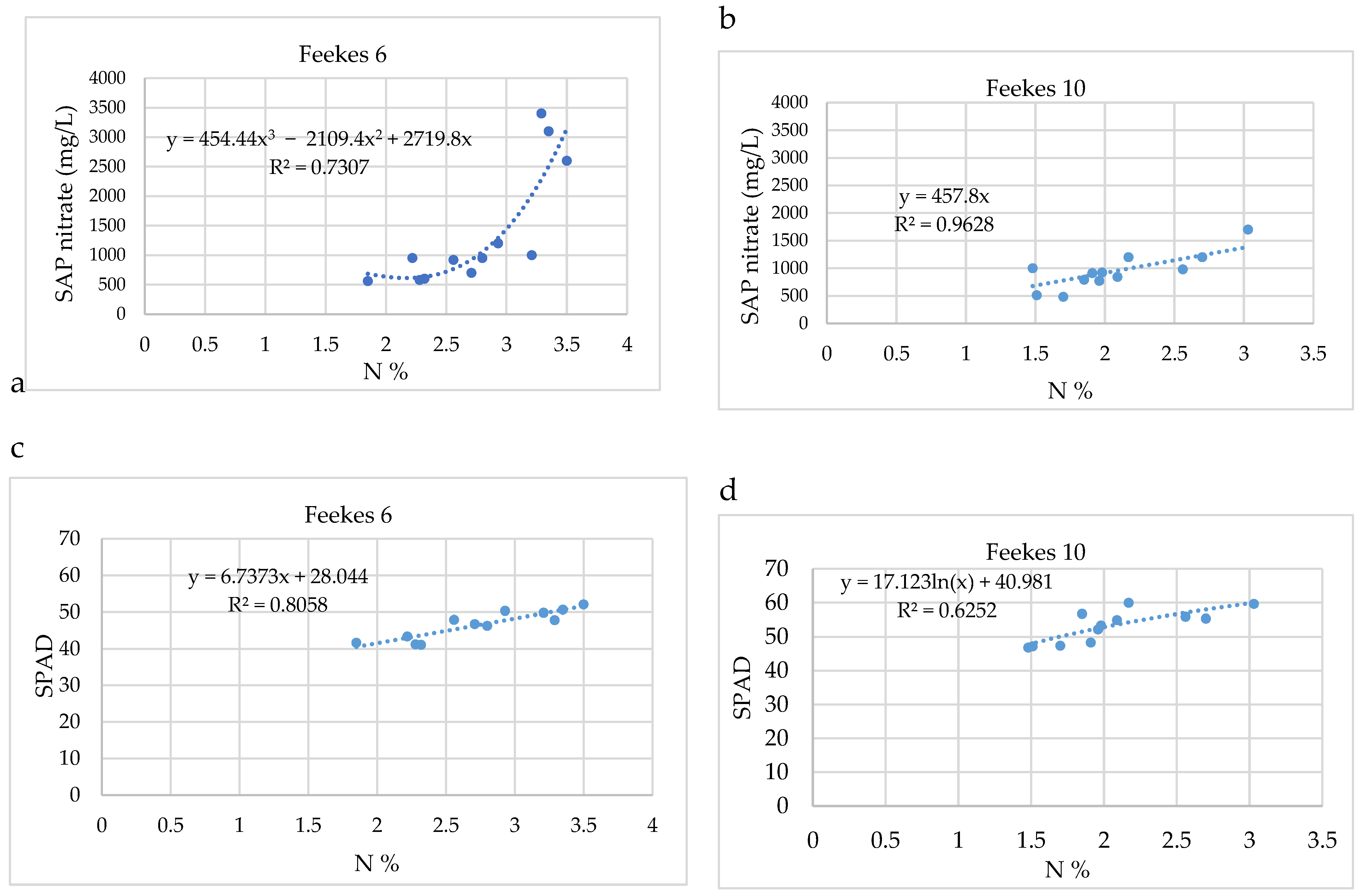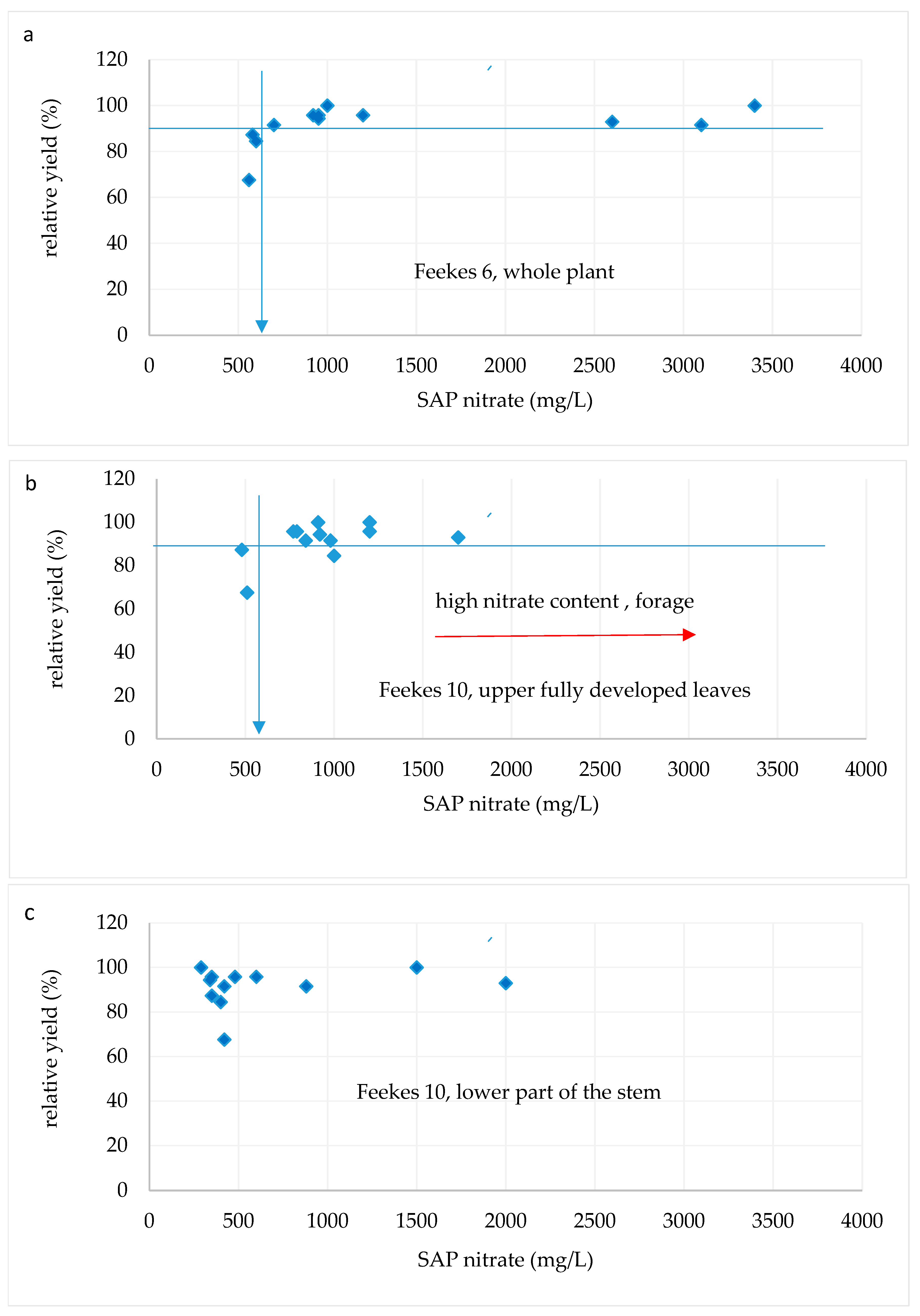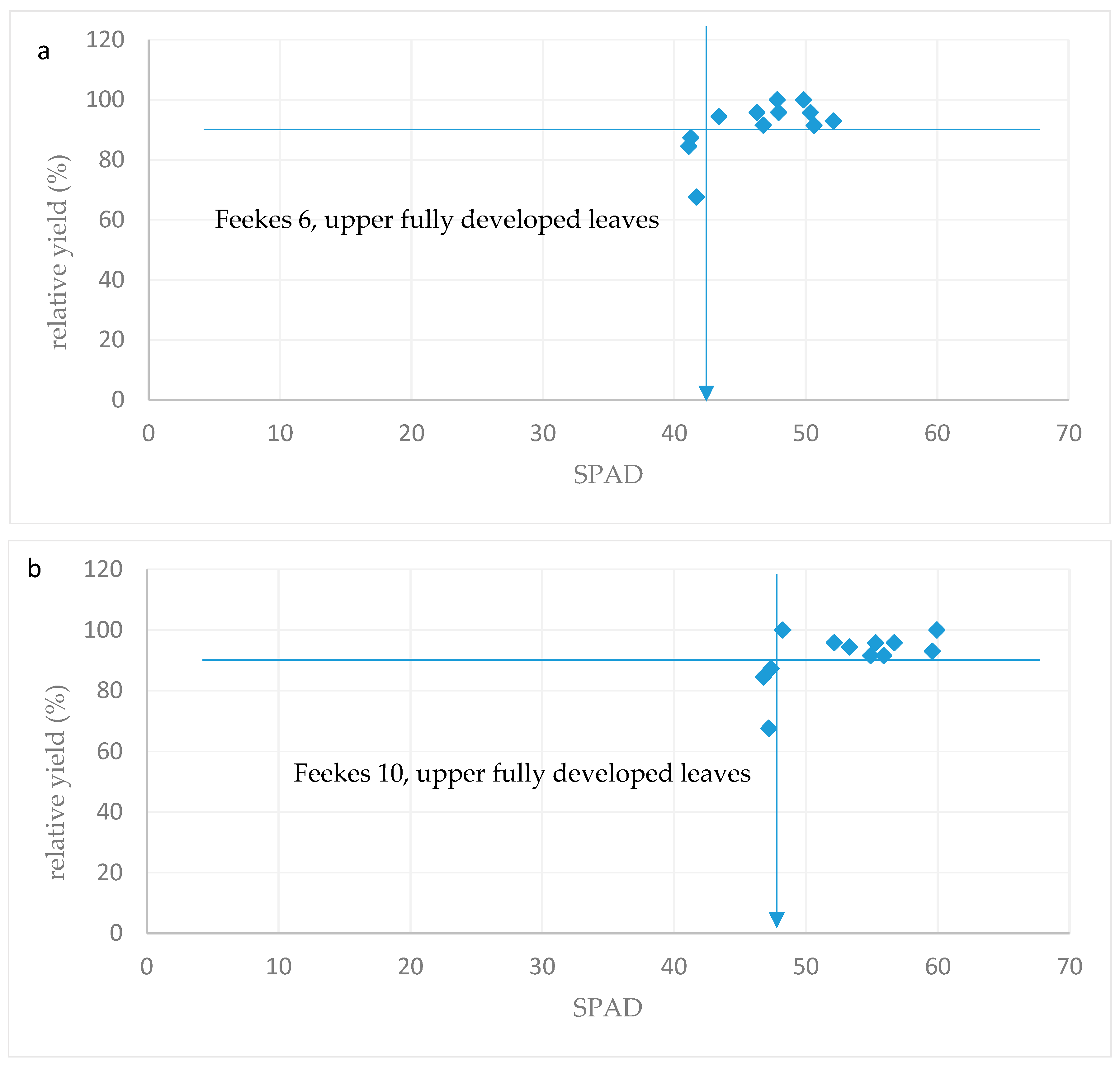Assessment of Spring Oat Nitrogen Supply Based on Plant Sap Nitrate Concentration and SPAD Values
Abstract
1. Introduction
2. Materials and Methods
2.1. Soil Characteristics and Experimental Setup
2.2. Plant and Soil Sampling, Measurement of Plant Sap Nitrate, Total N, SPAD Values, and Soil Mineral N Content
2.3. Measurements of Yield Reference Values
2.4. Statistical Evaluation and Estimation of Critical Nutrient Supply Values
3. Results and Discussion
4. Conclusions
Author Contributions
Funding
Data Availability Statement
Acknowledgments
Conflicts of Interest
References
- Thompson, R.B.; Tremblay, N.; Fink, M.; Gallardo, M.; Padilla, F.M. Tools and strategies for sustainable nitrogen fertilisation of vegetable crops. In Advances in Research on Fertilization Management of Vegetable Crops; Springer: Cham, Switzerland, 2017; pp. 11–63. [Google Scholar] [CrossRef]
- Farneselli, M.; Tei, F.; Simonne, E. Reliability of petiole sap test for N nutritional status assessing in processing tomato. J. Plant Nutr. 2014, 37, 270–278. [Google Scholar] [CrossRef]
- Padilla, F.M.; Farneselli, M.; Gianquinto, G.; Tei, F.; Thompson, R.B. Monitoring nitrogen status of vegetable crops and soils for optimal nitrogen management. Agric. Water Manag. 2020, 241, 106356. [Google Scholar] [CrossRef]
- Llanderal, A.; García-Caparrós, P.; Segura, M.L.; Contreras, J.I.; Lao, M.T. Nutritional changes in petiole sap over space and time in a tomato crop greenhouse. J. Plant Nutr. 2019, 42, 1205–1217. [Google Scholar] [CrossRef]
- Esteves, E.; Locatelli, G.; Bou, N.A.; Ferrarezi, R.S. Sap analysis: A powerful tool for monitoring plant nutrition. Horticulturae 2021, 7, 426. [Google Scholar] [CrossRef]
- Parks, S.E.; Irving, D.E.; Milham, P.J. A critical evaluation of on-farm rapid tests for measuring nitrate in leafy vegetables. Sci. Hortic. 2012, 134, 1–6. [Google Scholar] [CrossRef]
- Anderson, K.A.; Case, T.E. Evaluation of plant nitrate extraction techniques and effect of commonly used analytical methods of detection. Commun. Soil Sci. Plant Anal. 1999, 30, 1479–1495. [Google Scholar] [CrossRef]
- Zhang, H.; Smeal, D.; Arnold, R.N.; Gregory, E.J. Potato nitrogen management by monitoring petiole nitrate level. J. Plant Nutr. 1996, 19, 1405–1412. [Google Scholar] [CrossRef]
- Williams, C.M.J.; Maier, N.A. Determination of the nitrogen status of irrigated potato crop. I. Critical nutrient ranges for nitrate–nitrogen in petioles. J. Plant Nutr. 1990, 13, 971–984. [Google Scholar] [CrossRef]
- Rodríguez, A.; Peña-Fleitas, M.T.; Padilla, F.M.; Gallardo, M.; Thompson, R.B. Petiole sap nitrate concentration to assess crop nitrogen status of greenhouse sweet pepper. Sci. Hortic. 2021, 110, 157–285. [Google Scholar] [CrossRef]
- Hochmuth, G.; Maynard, D.; Vavrina, C.; Hanlon, E.; Simonne, E. Plant tissue analysis and interpretation for vegetable crops in Florida. In Nutrient Management of Vegetable and Row Crops Handbook; University of Florida Press: Gainesville, FL, USA, 2012; pp. 45–92. [Google Scholar] [CrossRef]
- Hochmuth, G.J. Plant Petiole Sap Testing: Guide for Vegetable Crops; University of Florida Cooperative Extension Service: Gainesville, FL, USA, 1994. [Google Scholar]
- Hoel, B.O. Determination of nitrogen status in winter wheat by measuring basal stem tissue sap nitrate concentration. Acta Agric. Scand. Sect. B-Plant Soil Sci. 1999, 49, 82–91. [Google Scholar] [CrossRef]
- Liu, X.; Ju, X.; Zhang, F.; Chen, X. Nitrogen recommendation for winter wheat using N min test and rapid plant tests in North China Plain. Commun. Soil Sci. Plant Anal. 2003, 34, 2539–2551. [Google Scholar] [CrossRef]
- Thompson, T.L.; Ottman, M.J.; Riley-Saxton, E. Basal stem nitrate tests for irrigated malting barley. Agron. J. 2004, 96, 516–524. [Google Scholar] [CrossRef]
- Delgado, J.A.; Follett, R.F. Sap test to determine nitrate-nitrogen concentrations in aboveground biomass of winter cover crops. Commun. Soil Sci. Plant Anal. 1998, 29, 545–559. [Google Scholar] [CrossRef]
- Veres, S.; Setzka, D.; Zsombik, L.; Rátonyi, T.; Makleit, P. Changes in Photosynthetic Capacity of Cucumber Seedlings in Response to Different Nitrogen Supply. Int. J. Food Eng. 2018, 4, 165–169. [Google Scholar] [CrossRef]
- Zhou, G.; Yin, X. Assessing nitrogen nutritional status, biomass and yield of cotton with NDVI, SPAD and petiole sap nitrate concentration. Exp. Agric. 2018, 54, 531–548. [Google Scholar] [CrossRef]
- Ali, A.M.; Salem, H.M. Site-Specific Nitrogen Fertilizer Management Using Canopy Reflectance Sensors, Chlorophyll Meters and Leaf Color Charts: A Review. Nitrogen 2024, 5, 828–856. [Google Scholar] [CrossRef]
- Rhezali, A.; Aissaoui, A.E. Feasibility study of using absolute SPAD values for standardized evaluation of corn nitrogen status. Nitrogen 2021, 2, 298–307. [Google Scholar] [CrossRef]
- Zhang, J.; Blackmer, A.M.; Ellsworth, J.W.; Koehler, K.J. Sensitivity of chlorophyll meters for diagnosing nitrogen deficiencies of corn in production agriculture. Agron. J. 2008, 100, 543–550. [Google Scholar] [CrossRef]
- Xiong, D.; Chen, J.; Yu, T.; Gao, W.; Ling, X.; Li, Y.; Peng, S.; Huang, J. SPAD-based leaf nitrogen estimation is impacted by environmental factors and crop leaf characteristics. Sci. Rep. 2015, 5, 13389. [Google Scholar] [CrossRef]
- Yuan, Z.; Cao, Q.; Zhang, K.; Ata-Ul-Karim, S.T.; Tian, Y.; Zhu, Y.; Liu, X. Optimal leaf positions for SPAD meter measurement in rice. Front. Plant Sci. 2016, 7, 719. [Google Scholar] [CrossRef]
- Monostori, I.; Árendás, T.; Hoffman, B.; Galiba, G.; Gierczik, K.; Szira, F.; Vágújfalvi, A. Relationship between SPAD value and grain yield can be affected by cultivar, environment and soil nitrogen content in wheat. Euphytica 2016, 211, 103–112. [Google Scholar] [CrossRef]
- Bytyqi, B.; Kutasy, E. Leaf reflectance characteristics and yield of spring oat varieties as influenced by varietal divergences and nutritional supply. Acta Agrar. Debreceniensis 2023, 1, 29–34. [Google Scholar] [CrossRef] [PubMed]
- Incrocci, L.; Massa, D.; Pardossi, A. New trends in the fertigation management of irrigated vegetable crops. Horticulturae 2017, 3, 37. [Google Scholar] [CrossRef]
- Zhang, L.; Hashimoto, N.; Saito, Y.; Obara, K.; Ishibashi, T.; Ito, R.; Yamamoto, S.; Maki, M.; Homma, K. Validation of relation between SPAD and rice grain protein content in farmer fields in the coastal area of Sendai, Japan. AgriEngineering 2023, 5, 369–379. [Google Scholar] [CrossRef]
- Fiorentini, M.; Zenobi, S.; Giorgini, E.; Basili, D.; Conti, C.; Pro, C.; Monaci, E.; Orsini, R. Nitrogen and chlorophyll status determination in durum wheat as influenced by fertilization and soil management: Preliminary results. PLoS ONE 2019, 14, e0225126. [Google Scholar] [CrossRef]
- Shi, Z.; Liu, D.; Liu, M.; Hafeez, M.B.; Wen, P.; Wang, X.; Wang, R.; Zhang, X.; Li, J. Optimized fertilizer recommendation method for nitrate residue control in a wheat–maize double cropping system in dryland farming. Field Crop. Res. 2021, 271, 108258. [Google Scholar] [CrossRef]
- Houba, V.; Temminghoff, E.; Gaikhorst, G.; Van Vark, W. Soil analysis procedures using 0.01 M calcium chloride as extraction reagent. Commun. Soil Sci. Plant Anal. 2000, 31, 1299–1396. [Google Scholar] [CrossRef]
- Sinclair, T.R. Historical changes in harvest index and crop nitrogen accumulation. Crop Sci. 1998, 38, 638–643. [Google Scholar] [CrossRef]
- Cate, R.B.; Nelson, L.A. Soil Testing Series Technical Bulletin 1; North Carolina State University International North Carolina State University: Raleigh, NC, USA, 1965. [Google Scholar]
- Berry, P.; Sterling, M.; Spink, J.; Baker, C.; Sylvester-Bradley, R.; Mooney, S.; Tams, A.; Ennos, A. Understanding and reducing lodging in cereals. Adv. Agron. 2004, 84, 215–269. [Google Scholar]
- Ragályi, P.; Szabó, A.; Rékási, M.; Csathó, P.; Csontos, P. Effect of Different Macronutrient Supply Levels on the Drought Tolerance of Rainfed Grass Based on Biomass Production, Water Use Efficiency and Macroelement Content. Horticulturae 2023, 9, 1337. [Google Scholar] [CrossRef]
- Mulvaney, R.; Khan, S.; Hoeft, R.; Brown, H. A soil organic nitrogen fraction that reduces the need for nitrogen fertilization. Soil Sci. Soc. Am. J. 2001, 65, 1164–1172. [Google Scholar] [CrossRef]
- Kádár, I.; Ragályi, P.; Murányi, A.; Radimszky, L.; Gajdó, A. Effect of Gérce alginit on the fertility of an acid sandy soil. Agrokémia Talajt. 2015, 64, 437–452. [Google Scholar] [CrossRef]
- Havlin, J.L. Soil: Fertility and nutrient management. In Landscape and Land Capacity; CRC Press: Boca Raton, FL, USA, 2020; pp. 251–265. [Google Scholar]
- Mahal, N.K.; Miguez, F.E.; Sawyer, J.E.; Dong, L.; Schnable, P.S.; Castellano, M.J. Stalk sap nitrate test as a potential tool for nitrogen fertilizer recommendations for maize. Field Crop. Res. 2024, 310, 109330. [Google Scholar] [CrossRef]
- Westcott, M.P.; Cash, S.D.; Jacobsen, J.S.; Carlson, G.R.; Welty, L.E. Sap analysis for diagnosis of nitrate accumulation in cereal forages. Commun. Soil Sci. Plant Anal. 1998, 29, 1355–1363. [Google Scholar] [CrossRef]






| N Rate (kg/ha) | Wet Grain Yield (t/ha) | Stem Length (cm) | Thousand Kernel Weight (g) | Harvest Index |
|---|---|---|---|---|
| 0 | 2.90 ± 0.17 a | 101.4 ± 5.3 a | 152.6 ± 32.6 a | 49.3 ± 5.1 b * |
| 30 | 3.39 ± 0.08 ab | 108.0 ± 5.0 a | 143 ± 17.8 a | 45.7 ± 2.9 b * |
| 60 | 3.54 ± 0.08 b | 116.7 ± 5.4 b | 175 ± 20.0 a | 45.8 ± 4.6 b * |
| 90 | 3.43 ± 0.16 ab | 115.8 ± 5.0 b | 130 ± 7.5 a | 44.6 ± 1.8 a * |
| Depth (cm) | Soil Mineral N Content (mg/kg) | |||
|---|---|---|---|---|
| N Rate (kg/ha) | ||||
| 0 | 30 | 60 | 90 | |
| 0–20 | 5.93 ± 3.46 a A | 6.23 ± 1.67 a A | 6.14 ± 3.13 a A | 8.37 ± 3.59 a A |
| 20–40 | 4.83 ± 3.41 a A | 7.18 ± 2.44 a A | 9.8 ± 0.34 a AB | 13.53 ± 3.33 a B |
| 40–60 | 5.86 ± 2.78 a A | 5.55 ± 2.93 a A | 11.39 ± 3.6 a AB | 16.33 ± 3.91 b B |
Disclaimer/Publisher’s Note: The statements, opinions and data contained in all publications are solely those of the individual author(s) and contributor(s) and not of MDPI and/or the editor(s). MDPI and/or the editor(s) disclaim responsibility for any injury to people or property resulting from any ideas, methods, instructions or products referred to in the content. |
© 2025 by the authors. Licensee MDPI, Basel, Switzerland. This article is an open access article distributed under the terms and conditions of the Creative Commons Attribution (CC BY) license (https://creativecommons.org/licenses/by/4.0/).
Share and Cite
Kremper, R.; Juhász, E.K.; Novák, T.; Kincses, I.; Sándor, Z.; Tállai, M.; Béni, Á.; Szabó, A.; Szarvas, S.; Balla Kovács, A. Assessment of Spring Oat Nitrogen Supply Based on Plant Sap Nitrate Concentration and SPAD Values. Nitrogen 2025, 6, 19. https://doi.org/10.3390/nitrogen6010019
Kremper R, Juhász EK, Novák T, Kincses I, Sándor Z, Tállai M, Béni Á, Szabó A, Szarvas S, Balla Kovács A. Assessment of Spring Oat Nitrogen Supply Based on Plant Sap Nitrate Concentration and SPAD Values. Nitrogen. 2025; 6(1):19. https://doi.org/10.3390/nitrogen6010019
Chicago/Turabian StyleKremper, Rita, Evelin Kármen Juhász, Tibor Novák, Ida Kincses, Zsolt Sándor, Magdolna Tállai, Áron Béni, Anita Szabó, Szabolcs Szarvas, and Andrea Balla Kovács. 2025. "Assessment of Spring Oat Nitrogen Supply Based on Plant Sap Nitrate Concentration and SPAD Values" Nitrogen 6, no. 1: 19. https://doi.org/10.3390/nitrogen6010019
APA StyleKremper, R., Juhász, E. K., Novák, T., Kincses, I., Sándor, Z., Tállai, M., Béni, Á., Szabó, A., Szarvas, S., & Balla Kovács, A. (2025). Assessment of Spring Oat Nitrogen Supply Based on Plant Sap Nitrate Concentration and SPAD Values. Nitrogen, 6(1), 19. https://doi.org/10.3390/nitrogen6010019







